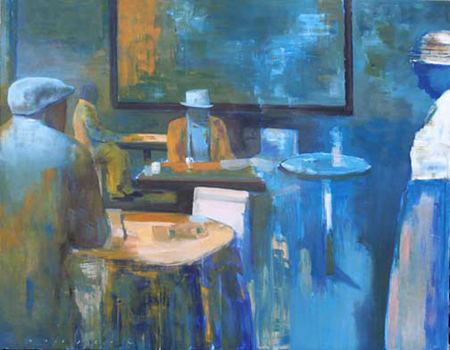Upon Reflection, Zachary Mason’s first New York City solo show, is the aptly named
photographic travelogue currently showing at the Decoy Workspace through January
20, 2016. Most striking is a nude self-portrait set in Central Park at night, framed by a
jogging path beside the Onassis Reservoir, an arching tree in the foreground creating its
sense of depth. An incandescent city looms in the background, reflected in the lake.
Mason redirects the viewer’s attention from cityscape to his eerie physical beauty,
capturing the wildness in him. Tall, trim, but muscled, the 26-year old artist has the
carriage of satyr.
As we see him leaning on the fence surrounding the water reflecting the city, he is a
young man at odds with the city. He is embracing it, yet is simultaneously totally out of
place. The victory over the commercialized metropolis, nonetheless, is his.
Enormously triumphant, the image if of a young man embracing Central Park while
completely ignoring decorum in a city populated by millions. His distinctive youthful
hopefulness, born of another, less tame locale, is unabashed.
Mason pays tribute to 1950’s photographer Vivian Maier throughout the show. Maier
created a series of self- portraits in black and white, most of which incorporated her
reflection, be it in a mirror at a yard sale or the glass window of a train car, to great critic
acclaim. Borrowing many of the same techniques, Mason brings them into a modern
world, in color.
There is a sense that we are witnessing a young artist whose gifted eye is becoming
aligned with an enlighted mind. All of the images in this show use reflection, some of
which, like those of Lincoln Center, a building in Soho, and one of the Mumbai Airport
demonstrate great appreciation for the line and architectural design. There are
numerous stunning landscapes including a star-filled night sky behind mountains
reflected in a lake in Moab, Utah and a skyline of Manhattan at dusk reflected in the
Onassis Reservoir. Viewers not be personally connected to these landscapes might
experience little emotional connection to them.
Mr. Mason’s work engages viewers most is when he takes his lead from Maier,
capturing the world with his reflection in it. There we see a young photographer at a
point of change, in an ever-changing world, striving to find a place for his being. We see
this in the wonderful image taken from behind a bus driver in Sir Lanka, the viewer
sharing his view point as he looks at himself in a rear view mirror and through the
dashboard window to a world that seems so far away but promises adventure to; a very
sophisticated image of a man sitting by himself in a coffee shop in midtown Manhattan,
taken through the store’s glass reflecting women strolling down the street; and paying
homage to Maier again, where the artist holds a camera as he takes a shot through
glass in the West Village. We see the colorful city reflected there, women and men
going about their busy lives, ivy growing up a red brick wall, and the photographer
finding his focus as he begins to see how he connects with others in the world.
Zachary Mason’s Upon Reflection opened at Decoy Workspace, a part-gallery, part-workshop hosting weekly events for the border-community intersection of the Upper East Side and East Harlem. It’s located on 1261 Park Ave; New York, NY 10029. The show run January 7, 2016-January 20, 2016.
Edited by Gabriella Radujko






 RSS
RSS
